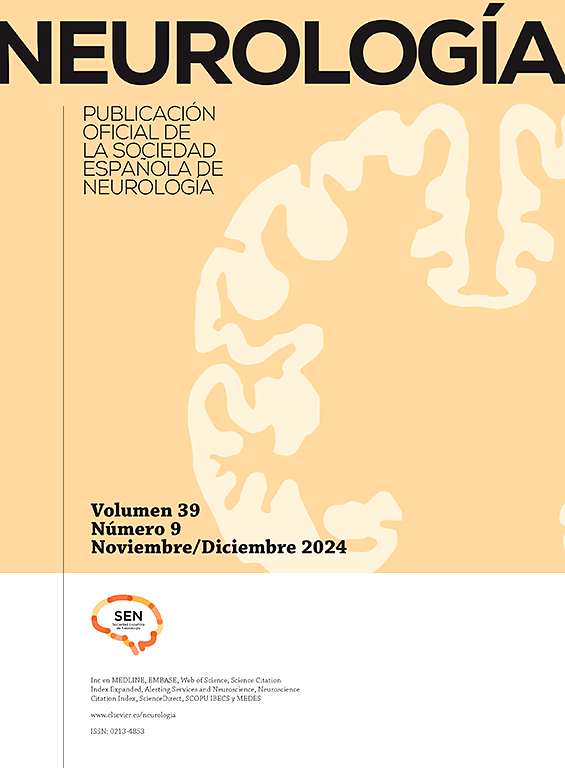北欧轻微中风和高危短暂性脑缺血发作的发病率和后果。IMMINENT 研究
IF 3.1
4区 医学
Q2 CLINICAL NEUROLOGY
引用次数: 0
摘要
本研究的主要目的是调查非心源性轻微急性缺血性卒中(AIS)和高风险短暂性脑缺血发作(TIA)的发生率,并确定卒中复发/死亡和严重出血的预测因素。我们还评估了这些患者在3个月时TIA的发生率、主要血管事件、治疗管理和功能不良预后的预测因素。方法回顾性分析2019年7月至12月NORDICTUS卒中网络所属19家医院急诊科评估的所有卒中患者的数据。纳入连续的非心源性轻微AIS (NIHSS≤5)和高危TIA (ABCD2≥6或同侧狭窄≥50%)患者。我们记录了临床、神经影像学和治疗变量。随访时间分别为30天和90天。采用改良Rankin评分(mRS)评价功能预后。结果在8275例患者中,1679例(20%)达到了迫在眉睫的标准(1524例AIS/155例TIA),导致每年全球发病率为48/100,000居民。73例(4.3%)患者发生卒中复发/死亡。颅外同侧狭窄(>50%): HR 1.999 (95% CI: 1.115-3.585, p = 0.020)和缺乏超急性脑动脉评估:HR 1.631 (95% CI: 1.009-2.636, p = 0.046)与90天卒中复发/死亡相关。颅内狭窄与预后不良相关(p = 0.044)。147例(9%)患者接受再灌注治疗,320例(21%)患者接受紧急双重抗血小板治疗。结论20%的脑卒中患者表现为非心源性高危TIA或轻微AIS。颅内外同侧狭窄和缺乏超急性脑动脉评估是卒中复发/死亡的预测因素;颅内狭窄与预后不良相关。尽管目前的建议,但DAPT的外显率很低。本文章由计算机程序翻译,如有差异,请以英文原文为准。
Incidence and outcoMes of MInor stroke and high-risk traNsient ischEmic attack in NordicTus. IMMINENT study
Background
Our primary aim was to investigate the incidence of non-cardioembolic minor acute ischemic stroke (AIS) and high-risk transient ischemic attack (TIA) and to identify predictors of stroke recurrence/death and severe bleeding. We also evaluated the rates of TIA, major vascular events, therapeutic management and predictors of poor functional outcome at 3 months in these patients.
Methods
We retrospectively reviewed data from all stroke patients evaluated at the emergency department of 19 hospitals belonging to the NORDICTUS stroke network between July and December 2019. Consecutive patients with non-cardioembolic minor AIS (NIHSS ≤5) and high-risk TIA (ABCD2 ≥6 or ipsilateral stenosis ≥50%) were included. We recorded clinical, neuroimaging and therapeutic variables. Follow-up was performed at 30 and 90 days. Functional prognosis was assessed with the modified Rankin scale score (mRS).
Results
Of 8275 patients, 1679 (20%) fulfilled IMMINENT criteria (1524 AIS/155 TIA), resulting in a global incidence of 48/100,000 inhabitants per-year. Recurrent stroke/death occurred in 73 (4.3%) patients. Extracranial ipsilateral stenosis (>50%): HR 1.999 (95% CI: 1.115–3.585, p = 0.020) and lack of hyperacute cerebral arterial assessment: HR 1.631 (95% CI: 1.009–2.636, p = 0.046) were associated with recurrent stroke/death at 90 days. Intracranial stenosis was associated with poor prognosis (p = 0.044). Reperfusion therapy was given to 147 (9%) and urgent double antiplatelet therapy (DAPT) to 320 (21%) patients.
Conclusion
Twenty percent of our stroke patients presented as non-cardioembolic high-risk TIA or minor AIS. Extracranial ipsilateral stenosis and lack of hyperacute cerebral arterial assessment were predictors of stroke recurrence/death; intracranial stenosis was associated with poor outcome. Despite current recommendations there was a low penetrance of DAPT.
求助全文
通过发布文献求助,成功后即可免费获取论文全文。
去求助
来源期刊

Neurologia
医学-临床神经学
CiteScore
5.90
自引率
2.60%
发文量
135
审稿时长
48 days
期刊介绍:
Neurología es la revista oficial de la Sociedad Española de Neurología y publica, desde 1986 contribuciones científicas en el campo de la neurología clínica y experimental. Los contenidos de Neurología abarcan desde la neuroepidemiología, la clínica neurológica, la gestión y asistencia neurológica y la terapéutica, a la investigación básica en neurociencias aplicada a la neurología. Las áreas temáticas de la revistas incluyen la neurologia infantil, la neuropsicología, la neurorehabilitación y la neurogeriatría. Los artículos publicados en Neurología siguen un proceso de revisión por doble ciego a fin de que los trabajos sean seleccionados atendiendo a su calidad, originalidad e interés y así estén sometidos a un proceso de mejora. El formato de artículos incluye Editoriales, Originales, Revisiones y Cartas al Editor, Neurología es el vehículo de información científica de reconocida calidad en profesionales interesados en la neurología que utilizan el español, como demuestra su inclusión en los más prestigiosos y selectivos índices bibliográficos del mundo.
 求助内容:
求助内容: 应助结果提醒方式:
应助结果提醒方式:


